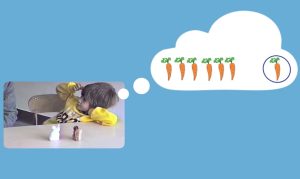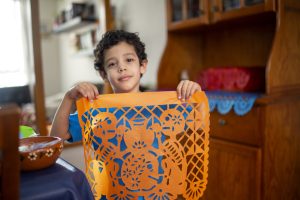- Learning as much as possible about an individual child’s math thinking can play an important role in supporting their early math development.
- Conversations about math help to uncover children’s thinking.
- Thinking Stories are a collection of resources that offer insights into children’s mathematical minds.
We know from many years of research that young children (from about age 3 through 6) begin to develop mathematical minds. Sometimes children develop surprising strategies for solving problems. For example:
- I asked 4-year-old Ben to count some yellow chips. He eventually got the correct amount (eight). Then I covered up the chips with paper and asked how many were underneath now. He spread his arms wide and said, “I give up.” He did not seem to know that the eight chips were still there even though he had just counted them. For him, out of sight meant out of mind.
- One of my graduate students asked a young girl to count. She counted: “one, two, three, five.” When asked why four was missing, the child replied that she was four. From the child’s point of view, she had ownership over the number four, so it could not be used in ordinary counting.
- I showed young Jennifer a toy rabbit and squirrel: “The rabbit has three carrots, and the squirrel has four. How many carrots do they have altogether?” I did not show her real carrots—Jennifer needed to imagine them in her mind. She does this but gets the wrong answer (six). Without correcting her, I asked: “How did you figure that out?” She said that she pictured in her mind four carrots and three carrots, then moved one from the group of three over to the group of four to get five carrots, and then another over to get six. At this point, she recognized her mistake and moved over the last imaginary carrot to get the correct answer of seven. This is remarkable! She developed her own sensible method for solving the problem—counting on, one at a time from the larger number. She made a mistake, leaving out one imaginary carrot, but when asked how she solved the problem, she thought and corrected herself.
Uncover Children’s Mathematical Minds
Asking children about the way they solve math questions can offer useful information about children’s math thinking. Parents, teachers, and others often fail to appreciate that their children might think differently from how they do.
My goal is to help adults enter and understand young children’s mathematical minds.
Knowing about children’s mathematical thinking helps you appreciate children’s creativity in solving problems they had not been taught to solve, and it sometimes reveals that they don’t understand something you thought they did.
Knowledge of an individual child’s thinking also helps you help the child learn. For example, in the case of Jennifer, I was less concerned with whether her answer was correct than with how she got it. My question about method led her to re-examine her strategy and implement it properly. By contrast, if I had simply told her that she was wrong or had just given her the correct answer, she would have learned very little.
Thinking Stories
To help you to understand individual children more deeply, we created Thinking Stories. The resources are based on videos of adult-child math conversations and accompanying text giving our interpretations. The narratives attempt to understand and portray how young children grapple with mathematical ideas.
Having studied these thinking stories, we encourage you to create your own—that is, to understand an individual child’s thinking. This will require talking to the child, asking some good questions (try these tips for having conversations about math), and observing the child. And then trying to make sense of it all.
Efforts to understand individual children’s math thinking will amaze you and make you a better teacher.



